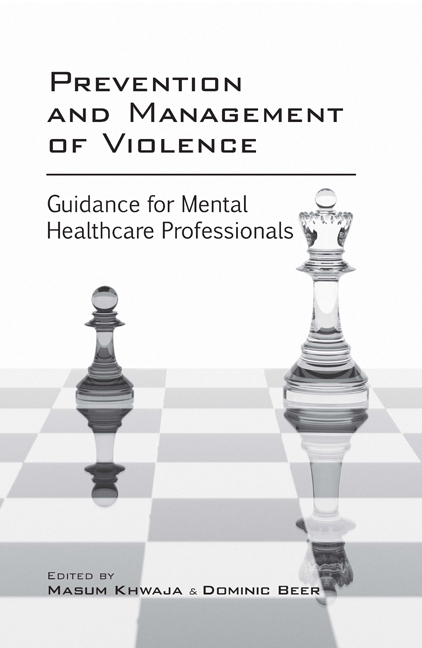Book contents
- Frontmatter
- Dedication
- Contents
- Abbreviations
- List of boxes and tables
- Working group
- Executive summary and recommendations
- 1 Legislation relevant to the management of violence by persons with mental disorders
- 2 Safeguarding vulnerable adults and children exposed to violence
- 3 Risk assessment and management
- 4 Risk prevention and non-pharmacological management of violence in acute settings
- 5 Use of medication and ECT in the management of violence
- 6 Post-incident management
- 7 Management of the risk of violence in the community
- 8 Management of violence in older adults
- 9 Management of violence in people with intellectual disability
- 10 Management of violence in prisons
- 11 Liaison with the police, Crown Prosecution Service and MAPPA
- 12 Information-sharing with victims of crime committed by persons with mental disorders
- 13 Clinical governance
- Appendix Organisations that victims of crime can contact
- Index
10 - Management of violence in prisons
- Frontmatter
- Dedication
- Contents
- Abbreviations
- List of boxes and tables
- Working group
- Executive summary and recommendations
- 1 Legislation relevant to the management of violence by persons with mental disorders
- 2 Safeguarding vulnerable adults and children exposed to violence
- 3 Risk assessment and management
- 4 Risk prevention and non-pharmacological management of violence in acute settings
- 5 Use of medication and ECT in the management of violence
- 6 Post-incident management
- 7 Management of the risk of violence in the community
- 8 Management of violence in older adults
- 9 Management of violence in people with intellectual disability
- 10 Management of violence in prisons
- 11 Liaison with the police, Crown Prosecution Service and MAPPA
- 12 Information-sharing with victims of crime committed by persons with mental disorders
- 13 Clinical governance
- Appendix Organisations that victims of crime can contact
- Index
Summary
In addition to security, one of the core responsibilities of a prison is the management of violence. This is embodied within Prison Service Order PSI 64/2011, Management of Prisoners at Risk of Harm to Self, to Others and from Others (Safer Custody) (National Offender Management Service, 2012) (replacing PSO 2750, Violence Reduction (HM Prison Service, 2007)), which details the concept within a prison. It sets out a framework for ‘delivering safer custody procedures and practices to ensure that prisons are safe places for all those who live and work there’. Perhaps in contrast to health services, its desired outcomes are to enable prisoners, staff and others feel safe and able to function effectively free from fear of violence, threatening behaviour, intimidation and bullying.
There is a national strategy which enables each prison to develop a local approach (or violence reduction strategy) within the resources available to them, and many prisons now have a violence reduction coordinator. Each establishment is required to have a strategy that incorporates the following:
• conflict resolution
• dynamic security
• effective risk management
• addressing organisational and environmental factors
• behaviour management for particular individuals
• offender management processes.
PSI 64/2011 states that each prison establishment is expected to have the capability (using the violence reduction toolkit) to develop a policy to reduce violence. Prisons are encouraged to adopt a problem-solving approach, based on collecting and analysing local data, formulating action plans and developing initiatives tailored to establishment needs. The focus is on a whole-prison approach, where ‘all aspects of service delivery and prison life are considered as opportunities to create a safer environment’ (HM Prison Service, 2007).
The Prison Service first defines violence with the starting point that certain levels can be tolerated or excused in any culture, but that toleration can lead to escalation. A common agreed threshold is, however, needed to allow others to report or challenge and apply appropriate sanctions.
It is to be noted that all staff who have contact with prisoners or carry out any form of assessment or management of prisoners, also have a responsibility for risk assessment and risk management.
The key aspects within the Prison Service are now discussed.
- Type
- Chapter
- Information
- Prevention and Management of ViolenceGuidance for Mental Health Professionals, pp. 96 - 102Publisher: Royal College of PsychiatristsFirst published in: 2017

